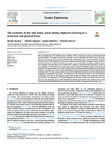The evolution of free and bound waves during dispersive focusing in a numerical and physical flume

Date
2018-02Author
Subject
Metadata
Show full item recordAbstract
Since the introduction of the NewWave theory (Lindgren, 1970), focused wave groups are used in physical and numerical studies to investigate the interaction of marine structures and ships with extreme waves. The propagation of such wave groups is associated with high order nonlinearities that can cause considerable deviations from linear and 2nd order predictions. Consequently, nonlinear numerical models or laboratory tests are needed to accurately describe the evolution of focused wave groups. In the present study, we validate a widely used two-phase Reynolds Averaged Navier-Stokes (RANS) solver realised in OpenFOAM with experimental results for the propagation of steep focused wave groups, using a newly developed methodology based on the separation of harmonics. This approach allows for accurate focusing of wave groups and in-detail examination of the individual evolution of the high order terms, as well as identifying the source of discrepancies between experiments and numerical models. The wave groups comprise long-crested broadbanded Gaussian spectra of increasing steepness propagating in intermediate water depth. The contribution of the nonlinear harmonics to the crest height and overall shape of the wave are also discussed, together with the effect of nonlinear wave interactions on the free-wave spectrum. The rapid growth of 3rd and 4th harmonics near focusing as well as the evolution of the free-wave spectrum, cause departures of up to 29% and 22% from analytic linear and 2nd order predictions. The present results demonstrate that RANS-VoF solvers constitute accurate models to propagate nearly breaking waves.
Description
Collections
Publisher
Journal
Volume
Pagination
Number
Recommended, similar items
The following license files are associated with this item:

